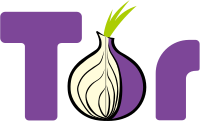Tor (anonymity network)
 |
|
| Developer(s) | The Tor Project, Inc |
|---|---|
| Initial release | 20 September 2002 |
| Stable release |
0.2.9.8(19 December 2016) |
| Preview release | 0.3.0.1-alpha(19 December 2016) |
| Repository | gitweb |
| Development status | Active |
| Written in | C,Python |
| Operating system | |
| Size | 2–4 MB |
| Type | Onion routing, Anonymity |
| License | BSD |
| Website | torproject |

Tor Browser on Linux Mint showing its start page - about:tor
|
|
| Developer(s) | Tor Project |
|---|---|
| Stable release | 6.0.8(13 December 2016) |
| Preview release | 6.5-alpha-6(13 December 2016) |
| Development status | Active |
| Operating system |
|
| Engine | Gecko |
| Size | 32–41 MB |
| Available in | 16 languages |
| Type | Onion routing, Anonymity, Web browser, Feed reader |
| License | GPL |
| Website | www |
 |
|
| Developer(s) | The Tor Project |
|---|---|
| Initial release | 29 October 2015 |
| Preview release |
0.3.0-beta-2 / 29 December 2016
|
| Repository | https://gitweb.torproject.org/tor-messenger-build.git |
| Development status | Active |
| Written in | C/C++, JavaScript, CSS, XUL |
| Operating system |
|
| Available in | English |
| Website | |
0.2.9.8(19 December 2016)
0.2.8.12(19 December 2016)
0.2.7.6(11 December 2015)
0.2.6.10(12 July 2015)
0.2.5.12(7 April 2015)
Tor is free software for enabling anonymous communication. The name is derived from an acronym for the original software project name "The Onion Router". Tor directs Internet traffic through a free, worldwide, volunteer network consisting of more than seven thousand relays to conceal a user's location and usage from anyone conducting network surveillance or traffic analysis. Using Tor makes it more difficult for Internet activity to be traced back to the user: this includes "visits to Web sites, online posts, instant messages, and other communication forms". Tor's use is intended to protect the personal privacy of users, as well as their freedom and ability to conduct confidential communication by keeping their Internet activities from being monitored.
Onion routing is implemented by encryption in the application layer of a communication protocol stack, nested like the layers of an onion. Tor encrypts the data, including the destination IP address, multiple times and sends it through a virtual circuit comprising successive, randomly selected Tor relays. Each relay decrypts a layer of encryption to reveal only the next relay in the circuit in order to pass the remaining encrypted data on to it. The final relay decrypts the innermost layer of encryption and sends the original data to its destination without revealing, or even knowing, the source IP address. Because the routing of the communication is partly concealed at every hop in the Tor circuit, this method eliminates any single point at which the communicating peers can be determined through network surveillance that relies upon knowing its source and destination.
...
Wikipedia
